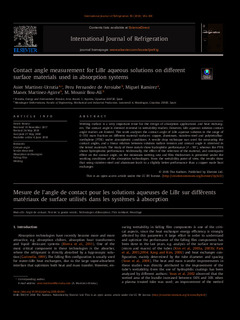Izenburua
Contact angle measurement for LiBr aqueous solutions on different surface materials used in absorption systemsArgitalpen data
2018Beste erakundeak
TecnaliaBertsioa
Bertsio argitaratuaDokumentu-mota
ArtikuluaArtikuluaHizkuntza
IngelesaEskubideak
© The AuthorsSarbidea
Sarbide irekiaArgitaratzailearen bertsioa
https://doi.org/10.1016/j.ijrefrig.2018.05.041Non argitaratua
International Journal of Refrigeration Vol. 95. Pp. 182-188. 2019Argitaratzailea
Elsevier Ltd.Gako-hitzak
Contact-angle
Sessile-drop-test
Absorption technologies
Falling-film ... [+]
Sessile-drop-test
Absorption technologies
Falling-film ... [+]
Contact-angle
Sessile-drop-test
Absorption technologies
Falling-film
Wetting [-]
Sessile-drop-test
Absorption technologies
Falling-film
Wetting [-]
Laburpena
Wetting surface is a very important issue for the design of absorption applications and heat exchangers. The contact angle is deemed essential in wettability studies; However, LiBr aqueous solution co ... [+]
Wetting surface is a very important issue for the design of absorption applications and heat exchangers. The contact angle is deemed essential in wettability studies; However, LiBr aqueous solution contact angle studies are limited. This work analyses the contact angle of LiBr aqueous solution in the range of 0–55% mass fraction on different material surfaces: copper, aluminum, stainless-steel and polytetrafluoroethylene (PTFE) under atmospheric conditions. A sessile drop technique was used for measuring the contact angles, and a linear relation between solution surface tension and contact angle is observed in the tested materials. The study of three metals show hydrophilic performance (θ < 90°), whereas the PTFE shows hydrophobic performance. Additionally, the effect of the selection of the material, and consequent effect on the contact angle, on the minimum wetting rate and film thicknesses is presented under the working conditions of the absorption technologies. From the wettability point of view, the results show that using stainless-steel and aluminum leads to a slightly better performance than a copper made heat exchanger. [-]
Sponsorship
Unión EuropeaProjectu ID
info:eu-repo/grantAgreement/EC/H2020/680738/EU/Industrial Energy and Environment Efficiency/Indus3EsBildumak
Item honek honako baimen-fitxategi hauek dauzka asoziatuta:






















